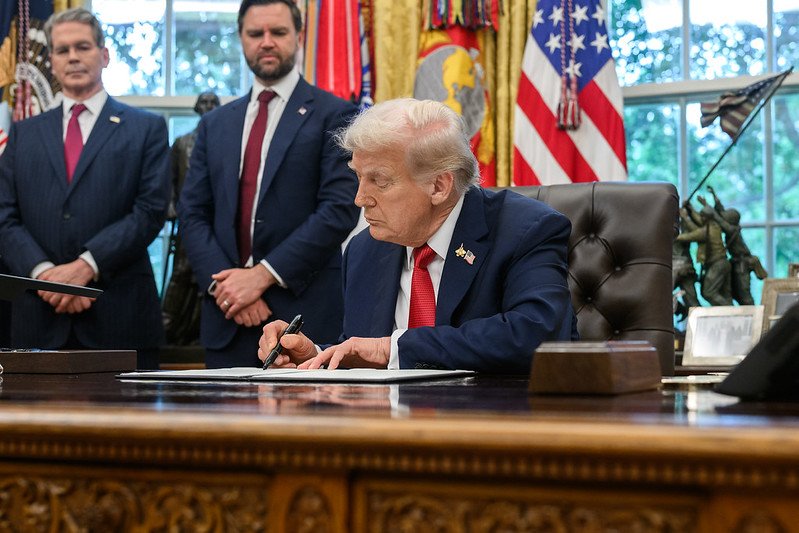What Trump's $100,000 H-1B Fee Means for Apprenticeship
The effects of the large increase are uncertain, but if H-1B funds decrease, the Secretary of Labor will have less money to spend on apprenticeship.
Blog Post

White House photo by Joyce N. Boghosian via flickr
Oct. 17, 2025
In late September, President Trump announced a dramatic increase in the fees for new petitions for H-1B visas, raising the cost—previously between $2,000 and $5,000—to $100,000. The announcement sent shockwaves through business circles, prompting a flurry of behind-the-scenes lobbying efforts and dire warnings not only from tech giants like Microsoft and Amazon but also from local healthcare and education leaders who rely on H-1B visa holders to staff hard-to-fill roles, especially in rural areas. Critics from both the right and the left agree that the H-1B visa program is in need of reform. They argue that low wages paid to H-1B workers hurt American workers, and cite evidence that H-1B workers are vulnerable to exploitation by their employers. It’s unclear if Trump’s recent proposal could meaningfully address either concern. But if it leads to a significant decline in the fees the H-1B program generates, it could have serious unintended consequences, undermining some of the most flexible dollars available to support the nation’s underfunded workforce training system, including apprenticeship.
It’s hard to know exactly how much revenue H-1B visa fees generate, but conservative estimates put it safely above a billion dollars annually. A portion of these comes from the American Competitiveness and Workforce Improvement Act Fee (ACWIA fee), which is charged to employers as part of their H-1B petitions. Each year, revenue from the ACWIA fees is then distributed to various federal agencies to support training investments across the country. If H-1B visas are meant to recruit foreign workers for roles Americans are unable to fill, the thinking goes, some of the money those visas generate should be used to help develop the skills we most need from American workers. About 56 percent of the ACWIA revenue is set aside for the U.S. Department of Labor, whose Secretary has the authority to direct the funds for demonstration programs and projects that provide technical skills training for American workers. Recent examples include the H-1B Rural Health Grants ($40 million, 2021) and the Building Pathways to Good Infrastructure Jobs initiative ($38 million, 2024).
H-1B dollars have also played a major role in expanding the nation’s Registered Apprenticeship system, which has grown by more than 60 percent since 2012. In President Trump’s first term, the Department of Labor (DOL) awarded $184 million through the Scaling Apprenticeship Through Sector-Based Strategies grants program, which supported the launch of new apprenticeship programs in industries reliant on H-1B visas, including healthcare and information technology. The following year, Trump’s DOL used $100 million in H-1B funding to support 28 public-private partnerships through the Apprenticeships: Closing the Skills Gaps initiative. Both have been credited with accelerating the growth of apprenticeship in high-growth industries and creating new, more affordable pathways to middle-class jobs and careers.
If the proposed $100,000 H-1B fee leads to a significant drop in visas issued—and many experts predict it will—it could also reduce the total revenue those visas generate. That means fewer dollars for Secretary Chavez-DeRemer to support training programs, including apprenticeship, which has no dedicated federal funding stream. The result would undercut the administration’s commitment to American workers and its goal of creating “one million active, new apprentices.”
Regardless of how the new fee structure plays out, the risks it poses lay bare how fragile apprenticeship funding already is. This instability doesn’t just disrupt grants. It makes it harder to engage employers in building programs that depend on steady, long-term investment. Worse, it denies workers access to reliable pathways into good jobs. Combined with proposed cuts to the Workforce Innovation and Opportunity Act, it’s yet another blow to an underfunded workforce system—and a clear signal the administration isn’t serious about supporting workers or employers facing acute talent needs. If policymakers truly want to support American workers by dramatically growing apprenticeship, they need to commit to new, more stable funding sources. Passing an expanded National Apprenticeship Act could be an important step toward stability. Until then, the least they can do is think twice before putting the limited funding the system does have in jeopardy.